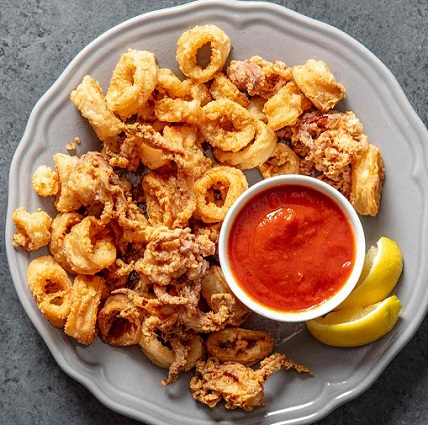Fried Calamari
Fried calamari, also known as fried squid, is a popular appetizer that has found its way onto menus worldwide. This dish combines the tender texture of squid with a crispy, golden-brown coating, creating a delightful contrast that appeals to seafood lovers and culinary adventurers alike.
The origins of fried calamari can be traced back to Mediterranean cuisine, particularly in countries like Italy, Greece, and Spain. However, its popularity has led to numerous regional variations, each adding its own twist to this classic dish.
In the United States, fried calamari gained widespread popularity in the 1980s, quickly becoming a staple in many restaurants, from casual eateries to upscale dining establishments.
Calamari, the Italian word for squid, refers to the edible members of the squid family. The most commonly used species for this dish is the European squid (Loligo vulgaris), prized for its tender meat and mild flavor.
When prepared correctly, fried calamari should be crispy on the outside and tender on the inside, never rubbery or chewy.
The key to perfect fried calamari lies in the preparation of the squid and the batter, as well as the frying technique. A light, well-seasoned coating and quick frying at high temperature ensure that the calamari remains tender while developing a crispy exterior.
Often served with a dipping sauce, such as marinara or aioli, fried calamari makes for an excellent appetizer or can be enjoyed as part of a larger seafood platter.
This recipe will guide you through creating restaurant-quality fried calamari in your own kitchen. Whether you’re preparing it for a dinner party, a family meal, or simply to satisfy a craving, this dish is sure to impress with its crispy texture and delicate flavor.
Ingredients:
- (Serves 4-6 as an appetizer)
For the calamari:
- 1 pound (450g) cleaned squid, tubes and tentacles
- 2 cups (240g) all-purpose flour
- 2 teaspoons salt
- 1 teaspoon black pepper
- 1 teaspoon garlic powder
- 1 teaspoon paprika
- 1/2 teaspoon cayenne pepper (optional)
- 2 large eggs
- 1/4 cup (60ml) milk
- Vegetable oil for frying
For the dipping sauce:
- 1/2 cup (120ml) mayonnaise
- 2 tablespoons lemon juice
- 1 clove garlic, minced
- 1 teaspoon fresh parsley, finely chopped
- Salt and pepper to taste
For serving:
- Lemon wedges
- Fresh parsley, chopped
- Marinara sauce (optional)
How to Make:
Prepare the squid:
If not already cleaned, clean the squid by removing the skin, cartilage, and innards. Rinse thoroughly under cold water.
Cut the squid bodies (tubes) into rings about 1/2 inch thick. Leave the tentacles whole or cut into smaller pieces if large.
Pat the squid pieces dry with paper towels to remove excess moisture.
Prepare the coating:
In a shallow bowl, mix together the flour, salt, black pepper, garlic powder, paprika, and cayenne pepper (if using).
In another bowl, whisk together the eggs and milk.
Make the dipping sauce:
In a small bowl, combine the mayonnaise, lemon juice, minced garlic, and chopped parsley.
Season with salt and pepper to taste.
Cover and refrigerate until ready to serve.
Coat the calamari:
Dip each piece of squid into the egg mixture, then coat it in the seasoned flour mixture, shaking off any excess.
Place the coated pieces on a clean plate or baking sheet.
Heat the oil:
In a large, heavy-bottomed pot or deep fryer, heat about 2 inches of vegetable oil to 350°F (175°C).
Use a thermometer to monitor the oil temperature for consistent results.
Fry the calamari:
Working in batches to avoid overcrowding, carefully lower the coated calamari into the hot oil.
Fry for about 2-3 minutes, or until golden brown and crispy.
Use a slotted spoon or spider skimmer to remove the fried calamari and transfer to a paper towel-lined plate to drain excess oil.
Allow the oil to return to 350°F (175°C) between batches.
Serve:
Transfer the fried calamari to a serving platter.
Garnish with chopped parsley and serve immediately with lemon wedges and the prepared dipping sauce.
Optionally, provide marinara sauce as an additional dipping option.
Chef’s Notes:
Squid selection: Fresh squid is ideal, but high-quality frozen squid can also produce excellent results. If using frozen, ensure it’s fully thawed and patted dry before coating.
Tenderizing: For extra tender calamari, you can soak the cleaned squid in milk for about 30 minutes before coating. This helps to tenderize the meat.
Temperature control: Maintaining the correct oil temperature is crucial. If the oil is too hot, the coating will burn before the squid is cooked. If it’s too cool, the calamari will absorb too much oil and become greasy.
Coating variations: For a lighter coating, you can use cornstarch instead of flour. For a crunchier texture, try mixing some cornmeal or panko breadcrumbs into the flour mixture.
Seasoning: Feel free to experiment with different spices in your flour mixture. Old Bay seasoning, Italian herbs, or even a touch of curry powder can add interesting flavors.
Avoiding sogginess: Serve the fried calamari immediately after cooking for the best texture. If you need to keep them warm, place them on a wire rack in a low oven (200°F/95°C) for no more than 10-15 minutes.
Sauce variations: While the lemon-garlic aioli is delicious, you can also serve fried calamari with marinara sauce, tartar sauce, or a spicy sriracha mayo for variety.
Leftover ideas: While fried calamari is best enjoyed fresh, any leftovers can be reheated in a 375°F (190°C) oven for about 10 minutes until crispy again. Avoid microwaving as this will make the calamari rubbery.
Nutritional Value: (Per serving, based on 6 servings)
Please note that these values are approximate and can vary based on specific ingredients and portion sizes:
- Calories: 300-350 kcal
- Total Fat: 15-20g
- Saturated Fat: 2-3g
- Monounsaturated Fat: 8-10g
- Polyunsaturated Fat: 4-5g
- Cholesterol: 150-200mg
- Sodium: 400-500mg
- Total Carbohydrates: 25-30g
- Dietary Fiber: 1-2g
- Sugars: 0-1g
- Protein: 15-20g
Fried calamari, while delicious, is typically considered an indulgence rather than a health food due to its preparation method. However, it does offer some nutritional benefits:
Protein: Squid is a good source of lean protein, which is essential for muscle building and repair.
Vitamins and Minerals: Squid contains various nutrients, including:
Vitamin B12: Important for nerve function and the formation of red blood cells
Selenium: An antioxidant that supports thyroid function
Zinc: Essential for immune function and wound healing
Copper: Necessary for forming red blood cells and maintaining nerve cells and the immune system
Omega-3 Fatty Acids: While not as high in omega-3s as some fish, squid does contain these beneficial fats, which are important for heart and brain health.
It’s important to note that the frying process adds significant calories and fat to the dish. The flour coating also increases the carbohydrate content. For those watching their calorie or fat intake, fried calamari should be enjoyed in moderation.
The high cholesterol content may be a concern for some individuals. However, dietary cholesterol doesn’t affect blood cholesterol levels in most people as much as previously thought. Still, those with specific health conditions should consult their healthcare provider about including fried calamari in their diet.
The dipping sauce adds additional calories and fat, primarily from the mayonnaise base. Using a lighter mayo or yogurt-based sauce can reduce the calorie content.
For a healthier alternative, consider grilling or baking the calamari instead of frying. These methods can significantly reduce the calorie and fat content while still providing a delicious seafood dish.
As with any food, fried calamari can be part of a balanced diet when consumed in moderation and alongside a variety of other nutritious foods.
Thanks for visiting Seafoods Recipe

